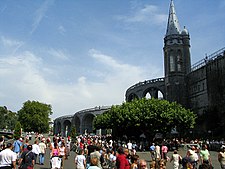盧爾德
維基百科,自由的百科全書
盧爾德是法國西南部上庇里牛斯省的一個市鎮,也是全法國天主教最大的朝聖地。
[編輯] 宗教聖地
盧爾德(Lourdes)是歐洲著名的天主教徒的朝聖之地。
據說在1858年有個叫貝娜黛特的女孩在城附近波河旁的山洞中看到聖母瑪利亞顯靈18次。從此小鎮成了天主教世界最著名的朝聖之地。
[編輯] 外部連結
- The Official Website of the Lourdes Sanctuaries
- Our Lady of Lourdes- yesterday Feb 11th
- The Song of Bernadette
Sanctuary of Lourdes
Yearly from March to October the Sanctuary of Our Lady of Lourdes or the Domain (as it is most commonly known) is a place of mass pilgrimage from Europe and other parts of the world. The spring water from the grotto is believed by some to possess healing properties, however there have been from the beginning sceptics of the miracles reported to have taken place in Lourdes. A common misconception is that miracles are the core of the Sanctuary of Lourdes, and the reasons for visits. Although this is probably the case for some visitors, the majority of pilgrims come as part of their Christian faith, and to help those in need.
An estimated 200 million people have visited the shrine since 1860 [3], and the Roman Catholic Church has officially recognized 67 miracle healings[3]. Especially impressive are candlelight and sacrament processions. Tours from all over the world are organized to visit the Sanctuary. Connected with this pilgrimage is often the consumption of or bathing in the Lourdes water which wells out of the Grotto.
At the time of the apparitions the grotto was on common land which was used by the villagers variously for pasturing animals, collecting firewood and as a garbage dump, and it possessed a reputation for being an unpleasant place.[4]
[edit] Hospitalité Notre-Dame de Lourdes
During one of the Virgin Mary’s apparitions to St Bernadette in 1858, she asked that people come in procession to the Grotto. In the early days care for sick pilgrims was provided by local nuns and charitable workers. As numbers of visitors grew, especially those from the rest of France, local facilities rapidly became swamped, and large groups such as the Hospitalité de Notre-Dame de Salut were set up, consisting of lay men and women whose objective was charitable aid to the sick pilgrims of Lourdes. The Hospitalité Notre-Dame de Lourdes splintered from the former group in 1885.[5]. Ever since there has been a "ministry of welcome" in Lourdes, receiving and caring for all the pilgrims who come to the apparition site, especially the sick and infirm.
The HNDL is active in Lourdes during the main pilgrimage season (which normally lasts from Easter until November), and it also provides people to welcome pilgrims at the Piscines (Baths) during the winter.
Pilgrimage groups are associated with many different organisations and charities. Many are from a specific region (for example British pilgrims generally travel with their own diocese or archdiocese), while others are based around a specific type of pilgrim. An example of this is the UK's Handicapped Children's Pilgrimage Trust (HCPT). HCPT takes disabled children and their carers on pilgrimage to Lourdes. HCPT groups are numbered, e.g. group 83 which leaves from Coventry. Another example is the Catholic Association Pilgrimage, which includes various dioceses, the Carmelites and groups under one umbrella.
[edit] Ukrainian Church
The five-domed St. Mary's Ukrainian Catholic Church in Lourdes was designed by Myroslav Nimciv, while its interior polychrome decorations were by famed artist Jerzy Nowosielski. The church is about a 10-minute walk from the basilica and the grotto, on a street named in honor of Ukraine, situated on a narrow piece of property close to the railroad station. Visible from the basilica, the height of the building makes up for its breadth[6].
The Ukrainian Catholic church is located on 8 Rue de l'Ukraine, 65100 Lourdes, France
[edit] Scepticism and criticism
Since the earliest of the apparitions, Lourdes has been the subject of intense debate regarding their nature. The earliest investigators, including the priest Abbey Dominique Peyramale, and the Police Commissioner M. Dominique Jacomet, were both initially convinced they were dealing with a hoax (each later changed his mind), and several researchers have since called several aspects of the Lourdes phenomenon into question.
The apparitions at Lourdes took place against the backdrop of a rich network of popular piety, which was common throughout the Pyrenean region in the 19th century. In the decades leading up to 1858, some children in small Pyrenean villages (on both sides of the border) claimed to see apparitions of the Virgin Mary in remote locations. Critics[citation needed] argue that Bernadette was simply repeating a well-tried trick to gain attention and notoriety
Modern Lourdes has no shortage of glitz on display. Some visitors may dislike the commercialism practised in parts of Lourdes, with neon-emblazoned gift shops overflowing with what Malcolm Muggeridge, although a supporter of the shrine, called "tawdry relics, the bric-a-brac of piety".[7] Critics argue that the Lourdes phenomenon is nothing more than a significant money spinner for the town and the region, which therefore has a strong vested interest in keeping the pilgrims coming;[8] however, the trinket shops are privately owned, and hawkers and souvenir stalls are strictly forbidden inside the sanctuary itself.



沒有留言:
張貼留言